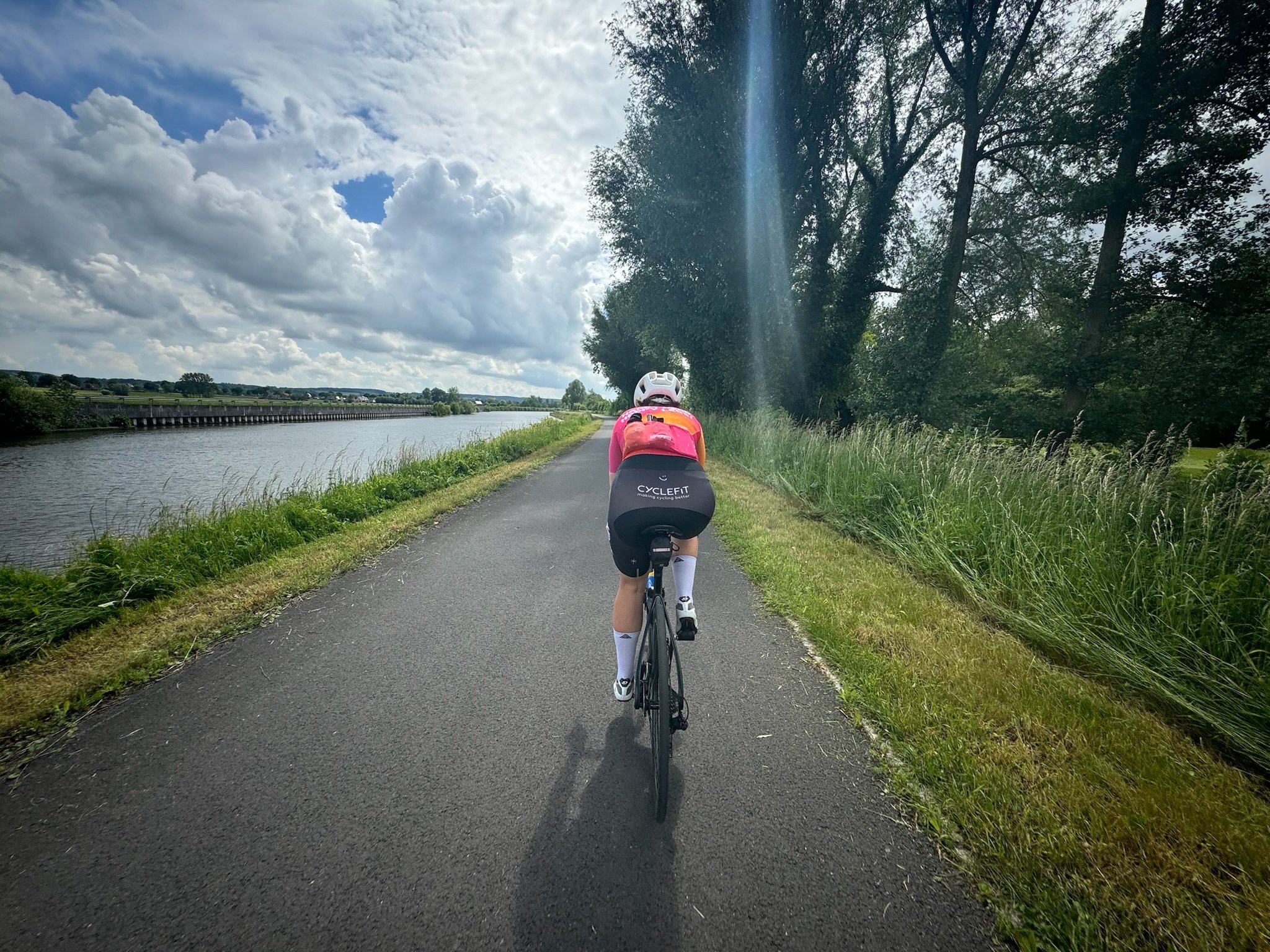
Body Fat Percentage Calculator
Understanding your body composition provides you with far more insight than just your weight. This tool estimates your body fat percentage, fat mass and lean mass. Whether you're a cyclist aiming to climb faster or just tracking progress across training phases, these values provide objective markers of change.
You can choose between different assessment methods:
Skinfold (4-site or 7-site) uses calliper measurements to estimate body fat via validated equations.
Circumference-based (US Navy method) provides a practical, equipment-free estimate using measurements of the neck, waist, and hips.
Each result is contextualised using sport-specific reference values. For example, elite endurance athletes typically fall under 12% body fat (for males) or 20% (for females), while active recreational athletes often range higher. This helps you monitor whether you’re maintaining, building, or leaning out appropriately for your sport or goal.
Enter your data, and you'll get a breakdown of your composition, your athletic classification, and a simple visual display. Use it periodically to assess how changes in training or nutrition are reflected in your physiological profile.

Anthropometry and Body Composition
Anthropometry means measuring the human body. In sport and exercise, it is often used to assess body size, shape, and composition. This includes measurements of fat mass and lean mass. At Saddle Up Cycling, we utilise these methods to help riders better understand how their bodies are adapting to training, fueling, and recovery.
Body composition refers to the proportion of your body that is comprised of fat compared to lean tissue, such as muscle, bone, and organs. For cyclists and endurance athletes, this is particularly important because it can impact performance, recovery, and resilience. However, aiming for the lowest possible body fat is not always the right goal. Health and function must come first.
Weight loss is often beneficial for improving the power-to-weight ratio, but not if it results in muscle loss. Any diet or weight management strategy should aim to preserve lean tissue. This is especially important for those who train regularly, as recovery and training adaptations rely on adequate protein and energy.
Why Measure Body Composition?
A bathroom scale only tells you your total body mass. It does not show whether you are gaining or losing fat or muscle. Two riders may weigh the same but have very different body compositions. This affects their ability to produce power, recover from sessions, and perform across longer events.
By tracking fat mass and lean mass over time, you can judge whether a change in weight is helping or harming your fitness. For example, if body fat is decreasing but muscle mass remains stable, that is likely a positive trend. However, if both are falling, you may need to adjust your training or eating habits.
What About BMI?
Body Mass Index, or BMI, is a general measure of body weight relative to height. It is widely used in healthcare to categorise individuals as underweight, normal weight, overweight, or obese. While it can be useful at a population level, especially in clinical settings, it does not accurately measure body composition and cannot distinguish between fat and muscle.
For athletes, BMI is often misleading. Cyclists and strength-trained individuals may have a high BMI due to increased muscle mass, not excess fat. This can result in being incorrectly labelled as overweight or unhealthy despite having low body fat and excellent fitness.
At Saddle Up Cycling, we do not use BMI to assess riders. It is not sensitive enough to detect meaningful changes in fat or muscle and is not suitable for tracking training adaptations. For anyone training regularly or aiming to improve performance, body composition is a far more accurate and informative measure.
How Is It Measured?
You do not need access to a lab or an expensive scan. There are two practical methods we recommend:
Skinfold Method (Using Callipers)
This method involves using a calliper to pinch and measure fat under the skin at several locations. The thickness of these skinfolds is used in equations to estimate body fat percentage. There are two main versions:
Four site method: biceps, triceps, subscapular, and suprailiac
Seven site method: includes chest, abdominal, thigh, and others
Yes, having a trained person take the measurements is ideal, and using a high-quality calliper such as the Harpenden type is recommended. But a friend and a budget calliper can still give useful information. The key is consistency. Use the same calliper, measure on the same side of the body, and ideally at the same time of day each time.
Circumference Method (Using a Tape Measure)
This is a simpler option that only requires a flexible tape measure. It estimates body fat based on the size of your neck, waist, and height. For females, hip circumference is also included. This method is less precise but easy to repeat at home and good for tracking general changes over time.
What You Will Learn
Once your measurements are entered, the calculator estimates your:
Body fat percentage
Fat mass in kilograms
Lean mass in kilograms
These are then compared to standard reference ranges for your sex, using general population norms. While age can influence these values, our model uses sex based classification to keep things simple and consistent.
| Category | Male | Female |
|---|---|---|
| Low | Less than 6 percent | Less than 12 percent |
| Elite | 6 to 12 percent | 12 to 20 percent |
| Competitive | 12 to 16 percent | 20 to 24 percent |
| Recreational | 16 to 22 percent | 24 to 28 percent |
| Non athletic | 22 to 30 percent | 28 to 38 percent |
If your body fat is below the elite range, it will be classified as low. That is not necessarily unhealthy, but it may be unsustainable unless carefully managed. If you are in the competitive or recreational bands, that is typical for trained cyclists, depending on their discipline and season.
How Often Should You Measure?
Checking once every four to six weeks is enough for most people. Changes in fat or lean tissue take time. Measuring too often will not show meaningful differences and may cause unnecessary stress. Focus on trends, not daily fluctuations.
Final Thoughts
At Saddle Up Cycling, we use body composition as one part of a wider performance picture. It helps guide discussions around fuelling, recovery, and seasonal goals. But numbers alone do not define an athlete. The best use of this tool is to support training, not replace it. Use it to inform, not judge.

References
Jackson, A. S., & Pollock, M. L. (1978). Generalized equations for predicting body density of men. British Journal of Nutrition, 40(3), 497–504. https://doi.org/10.1079/BJN19780152
Jackson, A. S., Pollock, M. L., & Ward, A. (1980). Generalized equations for predicting body density of women. Medicine and Science in Sports and Exercise, 12(3), 175–181.
Venables, M. C., Achten, J., & Jeukendrup, A. E. (2005). Determinants of fat oxidation during exercise in healthy men and women: A cross-sectional study. Journal of Applied Physiology, 98(1), 160–167. https://doi.org/10.1152/japplphysiol.00662.2003
Silva, A. M. et al. (2023). Body Composition Assessment in Elite Athletes: Comparison of Skinfold Thickness and Dual-Energy X-Ray Absorptiometry. Applied Sciences, 13(4), 2251. https://doi.org/10.3390/app13042251
Knechtle, B. et al. (2019). Body Composition in Sport: A Review. Frontiers in Physiology, 10, 684. https://doi.org/10.3389/fphys.2019.00684
U.S. Navy Method. Referenced by Hodgdon, J. A., & Beckett, M. B. (1984). Prediction of percent body fat for U.S. Navy men and women from body circumferences and height. Naval Health Research Center Report No. 84-29.
4-Site Skinfold Method (Durnin & Womersley)
Sum of skinfolds:
\( \text{Sum} = \text{Biceps} + \text{Triceps} + \text{Subscapular} + \text{Suprailiac} \)
Body density (male):
\( \text{Density} = 1.1631 - 0.0632 \cdot \log_{10}(\text{Sum}) \)
Body density (female):
\( \text{Density} = 1.1599 - 0.0717 \cdot \log_{10}(\text{Sum}) \)
Body fat percentage:
\( \text{Body Fat \%} = \frac{495}{\text{Density}} - 450 \)
7-Site Skinfold Method (Jackson & Pollock)
Sum of skinfolds:
\( \text{Sum} = \text{Chest} + \text{Abdominal} + \text{Thigh} + \text{Triceps} + \text{Subscapular} + \text{Suprailiac} + \text{Midaxillary} \)
Body density (male):
\( \text{Density} = 1.112 - 0.00043499 \cdot \text{Sum} + 0.00000055 \cdot \text{Sum}^2 - 0.00028826 \cdot \text{Age} \)
Body density (female):
\( \text{Density} = 1.097 - 0.00046971 \cdot \text{Sum} + 0.00000056 \cdot \text{Sum}^2 - 0.00012828 \cdot \text{Age} \)
Body fat percentage:
\( \text{Body Fat \%} = \frac{495}{\text{Density}} - 450 \)
US Navy Circumference Method
Body fat % (male):
\( \text{Body Fat \%} = 86.010 \cdot \log_{10}(\text{Waist} - \text{Neck}) - 70.041 \cdot \log_{10}(\text{Height}) + 36.76 \)
Body fat % (female):
\( \text{Body Fat \%} = 163.205 \cdot \log_{10}(\text{Waist} + \text{Hip} - \text{Neck}) - 97.684 \cdot \log_{10}(\text{Height}) - 78.387 \)
Derived Values
Fat mass:
\( \text{Fat Mass (kg)} = \text{Body Mass} \cdot \left( \frac{\text{Body Fat \%}}{100} \right) \)
Lean mass:
\( \text{Lean Mass (kg)} = \text{Body Mass} - \text{Fat Mass} \)
Power-to-weight ratio:
\( \text{W/kg} = \frac{\text{FTP}}{\text{Body Mass}} \)

